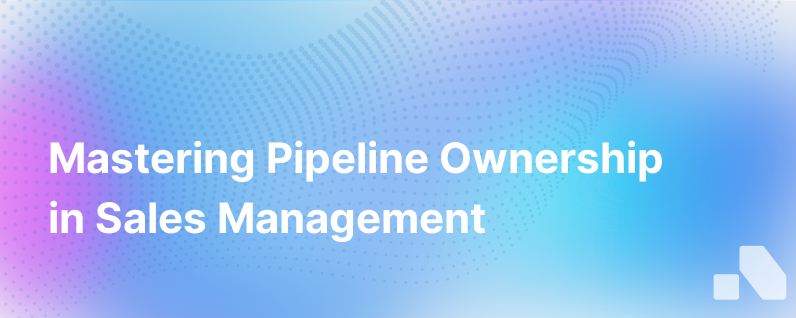Whose Pipeline Is It Anyway
Published on December 16, 2023 by David Zhang
The sales pipeline: a concept as foundational to sales organizations as code is to software development, serves as a principal framework for tracking progress and projecting revenue. Sales representatives diligently populate the pipeline with opportunities, while managers and leaders scrutinize it for growth potential and forecasting accuracy. Given the pipeline's significance, it's curious that its ownership is often a topic of ambiguity and contention within organizations. As we unravel this conundrum, let's delve into the nuances of pipeline ownership and the collective responsibility of ensuring its robustness and reliability.
The Traditional View of Pipeline Ownership
In a classical sales structure, the ownership of the pipeline tends to fall squarely on the shoulders of individual sales representatives. They are responsible for filling it with leads, nurturing these prospects through various stages, and ultimately shepherding deals to close. Their performance—and ostensibly the health of the pipeline—is frequently measured through activity metrics, such as the number of calls made, emails sent, and meetings scheduled.
Yet, in a high-functioning sales organization, this narrow attribution of ownership is both simplistic and restrictive. In reality, the pipeline is the product of numerous touchpoints and contributions from numerous internal factions, not just the sales team.
The Ecosystem of Pipeline Contributions
To understand the diverse stakeholders in pipeline development, one must consider the multifaceted journey from lead generation to deal closure.
-
Marketing: Often the initiators of pipeline momentum, marketing teams employ strategies to capture interest and convert it into leads. Various demand generation initiatives feed the top of the pipeline.
-
Sales Development Representatives (SDRs): Tasked with qualification and initial engagement, SDRs play a crucial role in assessing the viability of leads and transitioning them into the pipeline proper.
-
Product and Solutions Teams: Their insights ensure sales representatives have the necessary ammunition—product knowledge, use cases, and differentiators—to progress opportunities.
-
Customer Success and Support: In today's subscription-based and service-oriented models, customer retention and expansion are pivotal. These teams often unearth new opportunities within existing accounts.
-
Sales Operations: By refining processes and ensuring accessibility to accurate data, sales operations ensure the pipeline is reflective of true sales potential.
-
Sales Managers: Beyond ensuring individual performance, sales managers are responsible for the strategic oversight of the pipeline, including moving deals through stages and ensuring pipeline hygiene.
The Ownership Dilemma
The complexity arises from the interdependencies of these roles. Marketing may generate a plethora of leads, but they're meaningless without proper qualification by SDRs or sales representatives. Sales representatives may adeptly navigate the sales cycle, but their efforts are futile without the proper collateral and support from the product team. And sales operations must continuously refine the CRM and the sales process to maintain a pipeline that mirrors reality.
Herein lies the ownership dilemma: Whose pipeline is it anyway when so many functions are intricately involved?
Collaborative Ownership as the Solution
The answer, perhaps, does not lie in pinpointing a singular owner but rather in fostering a culture of shared ownership. Each stakeholder group is a guardian of the pipeline at various stages, ensuring its integrity and progression. The implications of this shared approach are manifold:
-
Shared Accountability: Goals should be aligned across functions, so when the pipeline thrives or falters, every contributing department reflects on its impact.
-
Seamless Handoffs: Collaborative ownership necessitates a system where reporting, transfer of information, and engagement with leads flow smoothly between departments.
-
Collective Visibility: The tools and systems used for pipeline management must grant appropriate stakeholders clear visibility into the pipeline's health and stages.
-
Continuous Communication: Regular cross-functional meetings and open channels of communication help each group recognize the others' challenges and contributions.
Realigning the Incentive Structure
To encourage collaborative ownership, incentive models must evolve beyond individual quotas and metrics. Comprehensive performance indicators that gauge the contributions and efficacy of each department to the pipeline can motivate synchronization and cooperative effort.
Embracing Technology for Shared Oversight
Technology plays a critical role in reinforcing this paradigm. Platforms that offer a unified perspective on the pipeline, coupled with robust analytics, can empower teams to identify gaps, predict trends, and cross-functionally strategize for improvements.
The Aomni Difference
In the grand scheme of pipeline dynamics, a tool like Aomni can be the difference-maker. Aomni seamlessly unites data across functions, delivering real-time pipeline insights enabling sales teams to refine their strategies and act quickly. With features that support team collaboration and offer actionable intelligence, Aomni is not just a resource—it exemplifies the philosophy of shared pipeline ownership.
Conclusion
In the enterprise cacophony, the question, "Whose pipeline is it anyway?" echoes. But as soon as one appreciates the shared stewardship intrinsic to effective pipeline management, the query shifts from one of possession to participation. Collective pipeline ownership isn't just a lofty ideal; it is the inevitable evolution of a progressive, integrated sales organization, and the key to unlocking unprecedented sales efficiency and effectiveness.